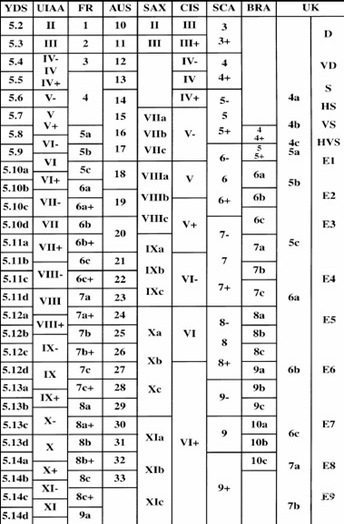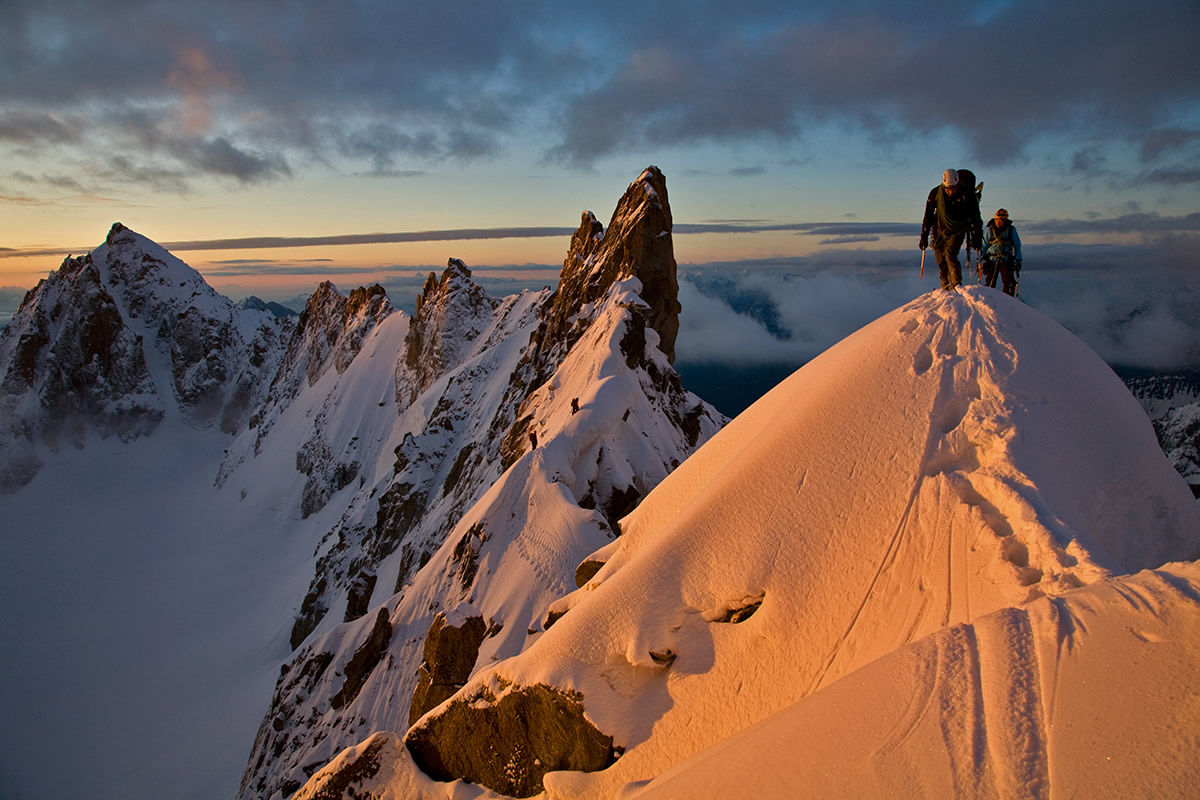The classification of mountaineering routes in the big mountains, adopted in the countries of the former USSR, is described in detail here: Mountaineering: routes, difficulty of sections, complexity categories.
A rather interesting situation has developed with the classification of mountaineering routes in Crimea. On the one hand, formally the same classification 1B – 6A applies here as in the big mountains. Moreover, Crimean routes, although in limited quantities, are accepted for the category: one of the standard ascents in the big mountains can be replaced by an ascent of the same category of difficulty in Crimea.
On the other hand, it is obvious that Crimean routes differ from routes in the big mountains: they are shorter (on average 200-400 m), but have greater technical complexity: sections that can be found on any Crimean 1B in the big mountains are on “troikas”, in extreme cases on short difficult 2B. In addition, Crimean routes are often uneven – for example, one rope is V, the rest are II-III.
A separate issue is the assessment of the difficulty of sections. Traditionally, the I – VI scale is used for this, with semi-categories designated by the + or – signs: VI+, IV-. In the new Crimea guidebooks (their author E. Poltavets – respectively, the chairman and member of the classification commission of the FAIS of Ukraine), this point is reflected as follows:
“Since the guide is aimed mainly at a mountaineering audience, the difficulty is assessed on a classic six-point scale using pluses and minuses – familiar to climbers in the post-Soviet space. It approximately corresponds to the French scale for assessing the difficulty of free climbing as follows: V (5a/5b), V+ (5c/6a), VI (6a/6b), VI+ (6b/6c)“
Obviously this is not the UIAA scale
| UIAA | F |
| II | 1 |
| III | 2 |
| IV IV+ |
3 |
| 4 | |
| V V+ |
|
| VI- | |
| 5a | |
| VI | |
| 5b | |
| VI+ | |
| 5c | |
| VII- | |
| 6a | |
| VII | |
| 6b | |
| VII+ | |
| 6c | |
| VIII- | |
| 6c+ | |
| VIII | |
| 7a | |
| 7a+ | |
| VIII+ | |
| IX- | |
| IX | |
| IX+ | |
| X- | |
| X | |
| X+ | |
| XI- | |
SUMMARY TABLE OF DIFFICULTY CATEGORIES

National Route Classification System (USA)
The NSCM route assessment is based on the “commitment” level and takes into account the amount of time required to complete the “medium” route team
I and II: Half a day or less of technical (climbing that requires protection) climbing.
III: Most of the day involves roped/protected movement
IV: Full day of technical climbing.
V: The route usually requires a bivouac or can be climbed in one day at a very fast pace by free climbing.
VI: Two or more days of difficult technical climbing
VII: Difficult walls climbed in alpine style.
Alpine System:
The overall difficulty of the entire route is based on a combination of the difficulties of the approach, ascent, and descent, including length, altitude, danger, degree of “commitment” and technical difficulty. This system originally used UIAA Roman numerals but has since switched to French nomenclature and has become popular worldwide.
F: Easy. Climbing on rock or soft snow, moving on simple glaciers. Generally moving without a rope except on glaciers.
PD: Not very difficult. Some technical climbing and moving on non-trivial glaciers.
AD: Quite difficult/challenging. Steep rock sections or long snow and ice slopes steeper than 50º; For experienced climbers only
D: Difficult. Long sections of difficult rock and/or ice or snow. Serious climbing.
TD: Very difficult. Long, difficult, inaccessible and highly technical routes
ED: Extremely difficult. The most difficult routes with continuous difficult sections. Further grades of difficulty are listed as ED1, ED2, etc.
Alaska Grading:
A general rating reflecting the remote, cold, stormy nature of Alaskan climbing. Rarely used outside of Alaska
1: Easy glacier route
2. Non-technical route on narrow, exposed ridges at altitude and in unstable weather.
3: Moderate climbing with some technical climbing
4: Hard to very hard
5: Very hard, long climbs in high engagement conditions. Possibly several bivouacs along the route.
6: Long, very difficult climbing with a large vertical gain (1 km) Large “commitment”.
Russian classification:
Overall assessment including UIAA technical grading (Roman numerals)
1B: Easy movement in ropes.
2A: Several pitches of easy climbing in ropes
2B: Elements of II+ and III climbing on a multi-pitch route.
3A: Contains 1-1.5 pitches of III-class climbing on a multi-pitch route.
3B: One or two pitchesIII+/IV grades on a full-day route.
4A: Full day of IV+ climbing
4B: Several pitches of IV+ or a small amount of V+ climbing
5A: Contains several pitches of V grade on a route lasting 1-3 days
5B: Two or more days with some VI+ climbing
6A and 6B: Multi-day routes with a large amount of VI+ climbing.
AID Classification:
New routes climbed by “wall climbers” often use the modern “New Wave” classification, using the symbols of the old aid classification with new meanings. In the case where the letter “C” replaces the letter “A”, the classification assumes “clean” climbing, i.e. Climbing without a hammer.
Classic Aid classification:
A0: The route is mostly free climbing with rare use of aid gear. No ladders/pitons are used. “pulling up” on quickdraws/fixed gear. Often called “French free” climbing
A1: All aid gear is reliable and easy to place.
A2: Gear is reliable, but requires accuracy/ingenuity in placement.
A3: Many difficult, unreliable gear, but without a high risk in case of a fall.
A4: Sections where all gear in a row supports no more than the static weight of a person.
A5: Long sections where all gear supports no more than the weight of a person. In case of failure – a fall of 20 meters or more
Classification of “New Wave” AID:
A1: Simple AID. All points are absolutely reliable
A2: AID of medium difficulty. Reliable points, but not so easy to install.
A2+: A 10-meter fall is possible from unreliable points, but without risk to life.
A3: Difficult AID. Many unreliable points in a row. Possibility of a 15-meter fall. Passing the rope can take several hours
A3+: A3, but a fall can lead to serious consequences
A4: Difficult AID. A 30-meter fall with a fall onto a ledge is possible. Long sections of unreliable points
A4+: Very difficult AID, with an even greater risk of a fall. Each pitch requires many hours of work.
A5: Extremely difficult aid. No single point along the entire length of the rope can hold a fall.
A6: A5 climbing, but the anchors also do not hold a fall. (A fall by one person causes the entire rope to fall.)
Scottish Winter Classification:
This classification applies to ice and mixed routes and is mainly used by climbers familiar with winter climbing in Scotland. Roman numerals are used to rate the overall difficulty, and Arabic numerals to rate the technical difficulty of the hardest section. The Scottish Technical Nomenclature is approximately 1 higher than the equivalent Waterfall Ice or Mixed grades. Technical rating 5 – relatively easy climbing, 6 – slightly technical mixed climbing, 7 and 8 – more “subtle” climbing, including difficult snow-covered rocks. At the moment, numbers from 4 to 9 are used. The full rating of the route is expressed, for example, as a pair: VI,8
I: Snow couloirs and easy ridges.
II: Steep snow, requiring two ice tools. Technical sections are short. Possible difficult cornice on the exit.
III: Mixed ascent on easy rock routes. Climbing long buttresses
IV: Steep ice with short vertical sections or long sections up to 70º, or mixed routes requiring “advanced” technique.
V: Long sections of 80º ice or mixed sections requiring long sequences of difficult moves. The routes are difficult, long and serious.
VI: Vertical ice and very technical mixed climbing. Class VI and above routes have very difficult sections throughout their length.
VII: Multi-pitch routes with long sections of vertical or thin ice, or mixed routes with intense, long, very technical climbing
VIII-IX: Scotland’s hardest routes
Canadian Winter Engagement Classification:
Combines length, danger, and overall difficulty
I-II: 1 or 2 pitches close to a road, but not recommended during avalanche season.
III: Requires most of the day, including the approach, which may require winter climbing skills in difficult terrain (avalanche zones, the ability to organize belay on snow)
IV: Multi-pitch at altitude or in difficult terrain. Multi-hour approaches on difficult mountain terrain.
V: Full day on mountain terrain with long approaches, a long technical descent and objective danger.
VI: Long waterfall in conditions found on large alpine routes (approaches, engagement). Previously required at least a day to complete, but nowadays it is completed faster by strong teams. Seriouslyobjective danger. (Avalanches, rockfall, etc.)
VII: Under discussion
Mixed Classification:
These routes require serious dry tooling (climbing with modern ice tools on rocks) and are climbed with crampons. The presence of ice as such on the route is not necessary, but as a rule there is ice.
M1-3: Easy. Slight slope, usually tools are not necessary.
M4: Relief from gentle to vertical, requiring simple technique with tools.
M5: Strenuous/long sections of work with tools.
M6: Vertical and overhanging sections requiring non-trivial work with tools
M7: Power and technical climbing on overhangs. No more than 10m of difficult climbing.
M8: The presence of almost horizontal overhangs (ceilings) requiring power and technical movements. The key sections are very difficult and longer than on M7
M9: Long vertical or slightly overhanging sections with small holds requiring high technique, or ceilings two to three “bodies” long with good “handles”.
M10: At least 10-meter ceilings or 30-meter overhanging sections with power movements and no rest opportunities.
M11: A full pitch of overhanging “gymnastic” climbing or ceilings up to 15 meters long
M12: M11 with “bouldering”, dynamic moves and non-trivial holds requiring fine technique.
Waterfall and Alpine Ice Classification:
Ice route ratings vary between regions and are still being “settled”. The classification below “averages” the available systems. The abbreviation WI refers to seasonal ice (usually waterfall ice). AI refers to permanent ice found in the mountains and can be subjectively easier with the same numerical nomenclature (e.g. AI5 is easier than WI5). Canadians often drop the “WI” symbol and classify routes by combining a Roman numeral for “commitment” and an Arabic numeral for the technical difficulty of the ice. (For example, II-5).
WI1: Not steep ice. No tools required.
WI2: General steepness of 60º with short steeper steps. Reliable protection.
WI3: Long 70º with long steps up to 80º-90º. Plenty of rest spots and easy placement of ice screws.
WI4: Long 80º sections, fairly long 90º sections with occasional rest spots.
WI5: Long and strenuous routes with 85º-90º for the entire rope, few good rest spots. Either a short section of thin or “bad” ice where it is difficult to secure.
WI6: Around -90º for the entire length of the rope with no rest areas, or a shorter section but even more “scary” than WI5. Very technical climbing.
WI7: As in WI6, but on thin, peeling ice, or long, overhanging, unstable icicles. Security is either impossible or very non-trivial and unreliable.
WI8: Under discussion.
Snow:
Snow is often classified by the maximum steepness of the slope. (e.g. 70º). Or by rough estimate of maximum steepness (eg: 70º-80º.)
Crimea
- Routes of category 1B difficulty: the length of the route itself is not less than 200 m. The route mainly consists of sections of category I, but should include 20-30-meter sections of category II and several short sections of category III.
- Routes of category 2A difficulty: the length of the route itself is not less than 200 m.
- The route mainly consists of sections of categories I and II, but should include 10-20-meter sections of category III, and short sections of category IV.
- Routes of category 2B difficulty: the length of the route itself is 200 m or more. The route mainly consists of sections of category II, but must include 15-30 m (or more) sections of category III+; IV-. Short 3-5 m sections of category IV+; V- are possible.
- Routes of category 3A difficulty: the length of the route itself is 200 m or more. The route mainly consists of sections of category II and III, but must include at least 10-20 m sections of IV and IV+. Short sections of category V are possible.
- Routes of category 3B difficulty: the length of the route itself is 200 m or more. The route mainly consists of sections of category II and III, but must include 20-30 m (or more) sections of category IV. The “key” section of the route is usually category V.
- Routes of category 4A difficulty:, the length of the route itself is 200 m or more. The route mainly consists of sections of categories II and III, but shoulden include 20-50-meter sections of category IV, as well as 5-10-meter sections of V
- Routes of category 4B difficulty: the length of the route itself is 200 m or more. The route mainly consists of sections of category III, but should include several 30-50-meter sections of category IV, and 10-20-meter sections of category V.
- Routes of category 5A difficulty: the length of the route itself is 200 m or more. The route mainly consists of sections of categories III and IV, but should include several 20-30-meter sections of category V and several 5-10-meter sections of V+; Category VI, it is possible to use simple ITO (A1; A2) in some places
- Routes of category 5B difficulty: the length of the route itself is 200 m or more. The route mainly consists of sections of category IV and V, but must include 30-meter (or more) sections of category V+, and at least two 10-20-meter sections of category VI. ITO A2 may be required
- Routes of category 6A difficulty: the length of the route itself is 300 m or more. The route mainly consists of sections of category V. The route must include 20-40-meter sections of category VI and VI+. Ito A2-A4 is used The total length of sections of category VI and A2-A3 is not less than 150 m
If we put this into a table, we get the following:
< td>*10-20+
| k.t. | I | II | III | IV | V | VI |
| 1B | * | 20-30 | + | |||
| 2A | * | |||||
| 2B | * | 15-20(+) | 3-5(+) | |||
| 3A | * | * | 10-20 | |||
| 3B | * | * | 20-30 | + | ||
| 4A | * | 20-50 | 5-10 | |||
| 4B | * | (30-50)x | (10-20)x | |||
| 5A | * | * | 20-30 | 5-10, | ||
| 5B | * | *, 30 V+ | (10-20) * 2 | |||
| 6A | * | (20-40)x = 150 |
Source: alp.org.ua

